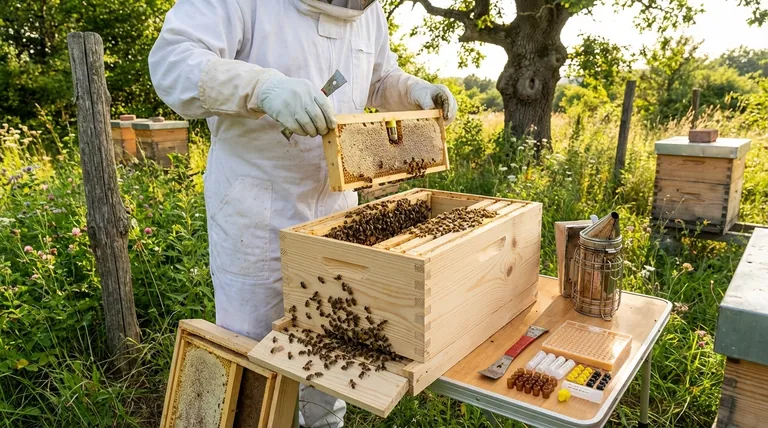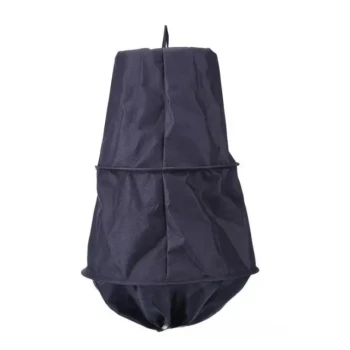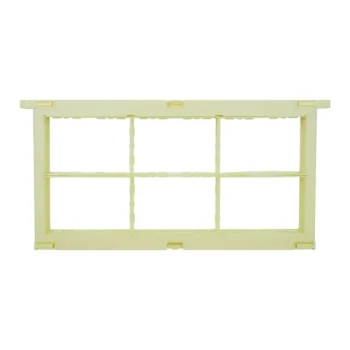In short, setting up a queen mating box involves creating a small, self-sufficient nucleus colony, or "nuc." This is done by stocking a small hive box with a frame of open brood, a frame of food stores (honey and pollen), and a healthy population of young nurse bees shaken from a donor hive.
The fundamental goal is not just to house a virgin queen, but to establish a stable, resource-rich micro-environment. This stability encourages the worker bees to accept the new queen cell and provides the support she needs to successfully mate and begin laying.

The Core Components of a Successful Mating Box
A mating nuc is a carefully balanced system. Each component serves a critical function in ensuring the colony remains viable and focused on caring for its new queen.
A Population of Young Nurse Bees
The foundation of the mating nuc is its population. You need enough bees to cover the brood, tend to the queen, and regulate temperature.
Young nurse bees are essential. They are primed to produce royal jelly and are the most likely to accept and care for a new queen cell or virgin queen. These are typically shaken from frames of open brood in a strong, healthy donor hive.
A Frame of Open Brood
Including a frame with eggs and young larvae is one of the most critical steps. It is the social "glue" that holds the new colony together.
The pheromones from open brood signal to the bees that they are a functioning colony. This powerfully discourages them from absconding (abandoning the nuc) and gives them a purpose while they await their new queen.
Essential Food Stores (Pollen & Honey)
A mating nuc is a closed system for its first few days and must have all the resources it needs to thrive.
Honey or nectar provides the carbohydrates for energy, while pollen provides the protein and lipids necessary to feed the larvae and the new queen. A frame with both is ideal.
The Queen Cell or Virgin Queen
The final piece is the queen herself. A mature, ready-to-hatch queen cell is typically introduced 24 hours after the nuc is established.
This waiting period gives the bees time to realize they are queenless, making them much more likely to accept the new queen cell when it is added.
Strategic Placement for Mating Success
Where you place the mating nuc is just as important as what you put inside it. The two primary goals are preventing bees from leaving and helping the queen find her way back home.
Preventing "Drift": The Isolation Principle
Bees have an incredibly strong homing instinct. If a mating nuc is placed too close to its powerful donor hive, many of the bees will "drift" back to their original home.
To prevent this, mating nucs should be set up several miles away from the donor apiary. If that isn't possible, keeping them confined for a day or two can help re-orient them to their new location.
Leveraging Landmarks for Orientation
A virgin queen will leave the nuc on several mating flights. Her ability to return safely depends on her ability to orient herself to the hive's location.
Placing the nuc near a distinct landmark—such as a unique tree, a fence post, or a brightly colored object—dramatically increases the chances of her successful return. Avoid placing nucs in a uniform, open field where every hive looks the same.
Understanding the Trade-offs: Nuc Size
The references mention using "nuc boxes," but the size and type can vary, each with its own advantages.
The Mini-Nuc Advantage: Efficiency
Very small mating nucs, often called "mini-nucs," are designed to conserve resources. They use small, custom frames and require far fewer bees.
This makes them highly efficient for beekeepers looking to raise a large number of queens with minimal impact on their production hives.
The Standard Nuc Advantage: Stability
Using a standard 4 or 5-frame nuc box provides a much more stable and forgiving environment. It has a larger population, better temperature regulation, and more resources.
While it requires more bees and brood, a standard nuc is more resilient to weather changes and has a lower risk of failure. It can also be grown directly into a full production colony once the queen is successfully laying.
Making the Right Choice for Your Goal
The proper setup depends entirely on your objectives as a beekeeper.
- If your primary focus is large-scale queen production: Use resource-efficient mini-nucs to maximize the number of queens you can raise from your donor hives.
- If your primary focus is raising a few high-quality queens with less risk: Use a standard 5-frame nuc for its superior stability and resilience.
Ultimately, a well-prepared mating nuc is the foundational nursery for every new colony you create.
Summary Table:
| Component | Purpose | Key Details |
|---|---|---|
| Young Nurse Bees | Care for the queen and brood | Shaken from a donor hive; primed to produce royal jelly. |
| Frame of Open Brood | Provides social stability | Pheromones prevent absconding and give the colony purpose. |
| Food Stores (Honey & Pollen) | Sustains the colony | Provides carbohydrates and protein for bees and larvae. |
| Strategic Placement | Ensures queen return | Place several miles away from donor hives and near landmarks. |
Ready to Elevate Your Queen Rearing Success?
Proper equipment is the foundation of a thriving apiary. At HONESTBEE, we supply commercial apiaries and beekeeping equipment distributors with the high-quality, durable supplies needed for efficient and successful operations—from nuc boxes to essential tools.
Let us help you build a more productive and profitable beekeeping business. Contact our expert team today to discuss your wholesale needs!
Visual Guide

Related Products
- Nicot Queen Rearing Kit for Beekeeping and Grafting in Nicot System
- Jenter Queen Rearing Kit Complete Set for Bee Breeding
- No Grafting Queen Rearing Kit: System for Royal Jelly Production and Queen Rearing
- Portable Bee Mating Hive Boxes Mini Mating Nucs 8 Frames for Queen Rearing
- Twin Queen Styrofoam Honey Bee Nucs Mating and Breeding Box
People Also Ask
- What should be done once eggs are present in the comb box? A Guide to Maximizing Queen Rearing Success
- What should be done to ensure grafted larvae are well-fed? Master the Principle of Abundance for Queen Rearing
- What is the Doolittle method of queen rearing? Master Controlled Queen Production for Your Apiary
- What are the methods of queen rearing? Master Grafting, Direct Lay & More
- What is essential for successful queen rearing in beekeeping? Master Genetics & Boost Your Apiary's Health



















